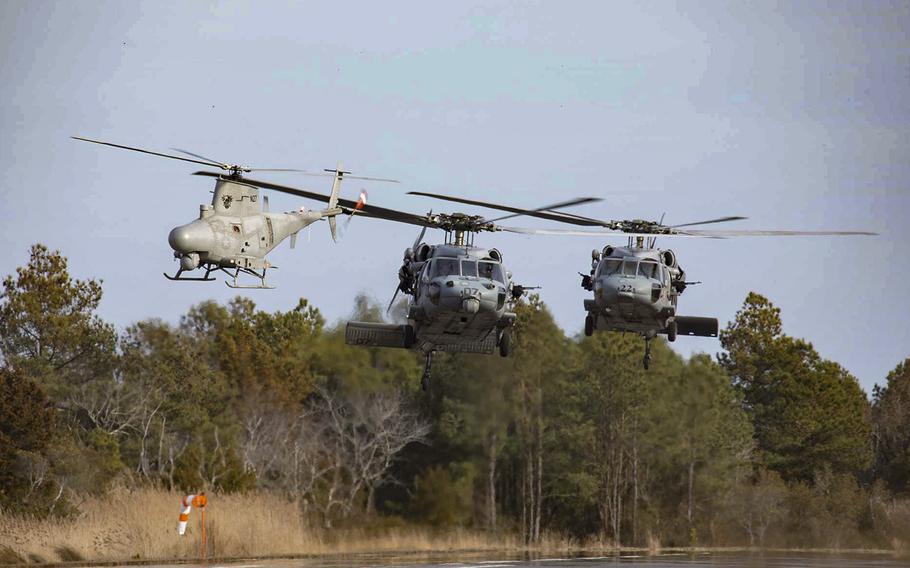
Two MH-60S Sea Hawk helicopters assigned to Helicopter Sea Combat Squadron 22, the “Sea Knights”, and one MQ-8B Fire Scout unmanned aerial vehicle conduct hover checks prior to a training flight at at NASA Goddard’s Wallops Flight Facility on Feb. 24, 2020. (U.S. Navy)
(Tribune News Service) — A four-man crew of Helicopter Sea Combat Squadron 22 took one last flight Wednesday, getting one last view from the sole remaining MH-60 Seahawk bearing the squadron’s “Sea Knight” emblem before it is taken out of operation.
On the ground at Naval Station Norfolk, the hangar buzzed as members of HSC-22 gathered. A banner on the far left side of the hangar read “Sea Knight Country.”
But come June 30, Sea Knight Country will be no more. A squadron that was once 300 strong has been stripped to about 150 sailors as it prepares to be dissolved.
“It’s a pretty sad day for the squadron, I can honestly say that I don’t think anyone at HSC-22 is happy to see the squadron sundown,” said Matthew Estep, chief helicopter aircrewman.
Wednesday’s flight culminated 16 years of service, throughout which the Sea Knights have supported wartime and peacetime missions. Estep has been with HSC-22 for eight of those 16 years.
“Everyone here, truthfully, is a team and it’s sad to see the squadron shut down, but we are sending ourselves off with a true legacy of teamwork and successful operations,” Estep said.
The mission of HSC-22 was to deploy helicopter detachments for littoral combat ships, amphibious ready groups and combat logistics ships for such things as special warfare, search and rescue, theater security cooperation, humanitarian assistance or disaster relief.
In recent years, the squadron has supported the U.S. 4th Fleet with counter narcotics operations and the U.S. 6th Fleet in the Baltic Sea.
“We are just re-aligning with the capacity that we have and the needs of the Navy,” Cmdr. Aaron “Dempsey” Berger said.
The squadron had more than a dozen manned and unmanned aircraft. As the squadron dissolves, some are being distributed to other squadrons, others will be sent to the Aerospace Maintenance and Regeneration Group in Arizona. There, the helicopters will be put into long-term preservation storage in the event they are recalled or need to be stripped for parts.
All the sailors at the squadron will transfer or leave the service by June 30.
Berger, the commanding officer, was one of two pilots at the controls during the final flight. Moments after landing, he rushed to hug his wife and daughter, who splashed him with a pail of water just outside the hangar.
Several members of the crew followed behind with three large buckets and a water hose, dousing him as part of a traditional Navy “wet down.”
For the sundown flight, he and his crew traveled to Kill Devil Hills, where they flew over the Wright Brothers National Memorial before returning to Norfolk. The same journey was made on the squadron’s maiden flight.
“It was amazing. It was an honor ... And leading these men and women has been incredible,” Berger said.
Following the final flight, Berger — still sopping wet — addressed the skeleton crew.
“(HSC) 22 wouldn’t be where it is today without all your hard work ... I think we have raised the standard on the seawall,” Berger said to his crew.
Berger said he hopes the culture of the squadron lives on.
“If you ask anyone on the seawall or anyone that operated with us who they want to work with, they want to work with HSC-22. And that’s truly how professional we are. We show up. We execute on time with a smile on our face. When asked to do something, we lead with ‘Yes.’... I don’t think many other organizations truly have that culture like we built here,” Berger said.
As the bittersweet celebration concluded, Berger called out, “Knights of the Sea!”
“Best on the wall!” the crew bellowed.
©2023 The Virginian-Pilot.
Visit pilotonline.com.
Distributed by Tribune Content Agency, LLC.